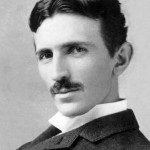 During the “War of the Electric Currents,” the battle was waged over whether Direct Current (DC) would hold off Alternating Current (AC) for the future of America’s electricity. Nikola Tesla invented the system and components that made it possible to transmit alternating current to virtually unlimited distances, a limitation that had plagued direct current. Tesla teamed up with George Westinghouse, which shot them to the forefront of the race to get lucrative contracts lighting the Chicago World’s Fair and getting hydroelectric power from Niagara Falls.
During the “War of the Electric Currents,” the battle was waged over whether Direct Current (DC) would hold off Alternating Current (AC) for the future of America’s electricity. Nikola Tesla invented the system and components that made it possible to transmit alternating current to virtually unlimited distances, a limitation that had plagued direct current. Tesla teamed up with George Westinghouse, which shot them to the forefront of the race to get lucrative contracts lighting the Chicago World’s Fair and getting hydroelectric power from Niagara Falls.
Edison’s reaction to the teamwork of Westinghouse and Tesla was immediate. He had pamphlets printed and mailed to reporters and lighting utilities that accused Westinghouse and other Edison competitors of being in violation of his patents. Edison also started pushing the idea of the dangers of alternating current at high voltages versus the safety of his low voltage direct current.
The technical battle was mostly the dry stuff of scientists and argued deep inside the technical journals and scientific meetings. Most of this was not visible, and certainly not understandable, to the general public. But one thing that was understandable was the occasional death by electrocution. And with cities like New York strung tight with hundreds of electrical wires from a dozen electric light utilities, the public feared the occasional might become more frequent.
Edison got some help in this regard from a few grizzly electrocutions that occurred over a short period of time. One such occasion was the unfortunate circumstance of an electrical repairman named John Feeks, who fell into a spider web of charged wires and was slowly incinerated as the horrified pedestrians on the street below gazed up at the gruesome scene. Needless to say this bolstered Edison’s case that alternating current current was too dangerous to be used while direct current – on which his own systems were based – was perfectly safe.
But a few accidents weren’t going to be enough to convince the public that alternating current should be banned from all use. It would take a lot more death to do that.
Ever the opportunist, Edison enlisted the help of Harold Pitney Brown, an electrician with a decade of experience and a bit of a mean streak. Brown set up shop in Edison’s laboratory and proceeded to electrocute stray dogs – which he paid neighborhood kids to acquire – with alternating current electricity. Edison called these animal executions getting “Westinghoused” because of the use of the alternating current system that his main competitor, using Tesla’s technology, was developing. Later the term “Westinghoused” would be applied to the first execution by electrical current. On August 6, 1890, New York State accomplished the first execution using the new alternating current electric chair. William Kemmler had murdered his philandering wife with an axe and then calmly asked his son to contact the local police. He was tried, found guilty, and sentenced to death. Edison had convinced the board that Kemmler’s death would be rapid and painless because of the incredibly high voltages by the dangerous alternating current.
When the day came, however, the execution did not go smoothly. No, it did not go smoothly at all.
[The above is an adaptation modified for the purposes of this short space. Much more (and the riveting execution) will be in my book: Tesla: The Wizard of Electricity.]
David J. Kent is the author of Tesla: The Wizard of Electricity (2013) and Edison: The Inventor of the Modern World (2016) (both Fall River Press). He has also written two e-books: Nikola Tesla: Renewable Energy Ahead of Its Time and Abraham Lincoln and Nikola Tesla: Connected by Fate.
Follow me by subscribing by email on the home page. And feel free to “Like” my Facebook author’s page and connect on LinkedIn. Share with your friends using the buttons below.










